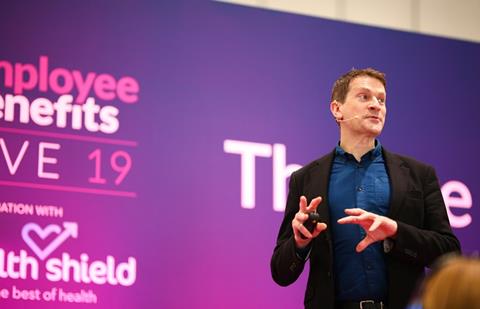
Employee Benefits Live 2019: Addressing delegates in the opening keynote of the 21st annual Employee Benefits Live conference, Bruce Daisley, vice president, Europe, Middle East and Africa (EMEA) at Twitter, spoke about how organisations can improve the employee experience at work.
Daisley drew attention to five key points that he believes will help improve work for both organisations and their employees.
The first centred on recognising how the human brain works, and realising that employees need space to escape constant pressures, to enable to the brain’s default network and creative impulses to thrive. “If your employees are going to back to back meetings, when are they getting the opportunity to get any thinking done?” asked Daisley.
The second point focused on understanding how teams work, he continued: “This is really fascinating, because it has very big bearings for how we’re thinking about working from home and working remotely. There seems to be far more about the way human beings connect with each together relating to our physicality and our proximity, than we ever realised before."
Daisley explained that while employee may not have to be in the room together at all times, feeling connected has a measurable impact on the experience they have at work.
The third point is to understand how the impact that downtime has on work and productivity. “We often regard breaks and conversation as moments of indolence,” said Daisley. “[But] connecting people together seems to be incredibly empowering for our experience of work.”
Employers then need to understand how to create a culture and employee experience that starts from the moment an employee joins the organisation, and the long-lasting effect this can have on the individual and the organisation.
Finally, Daisley spoke about the importance of belonging: “Loneliness has a really big bearing. If we’re thinking about the experience of people at work, we need to think about serving human needs, it’s those human needs that are making sure people feel a sense of belonging in their working environment.”
Daisley concluded: “As we’re thinking about the future of work, it’s very easy to think that the future of work is about the next technology you employ or the next app you get your employees to do.
“I think all of the evidence says very much the opposite of that. When we’re thinking about the future of work, we need to think about how we bring the humanity back into our jobs. If we treat improving work as an exercise in improving humanity, the human experience, I think we’re probably more likely to achieve a great outcome.”
















